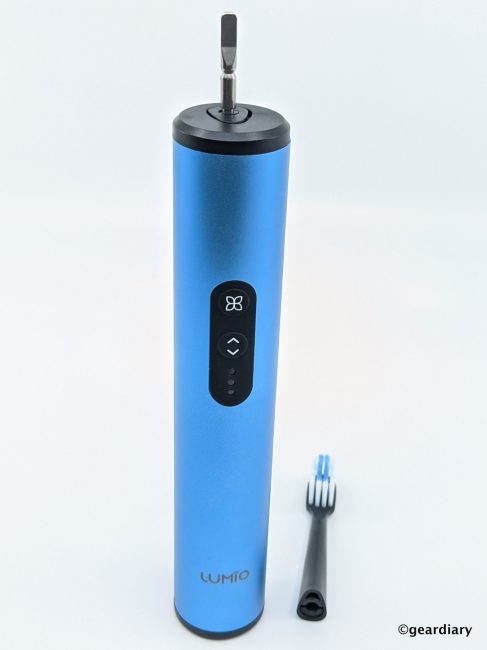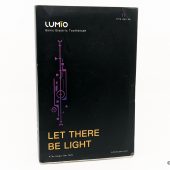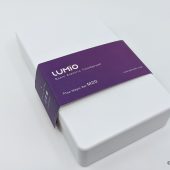If the thought of poop particles on your toothbrush doesn’t give you pause, maybe the knowledge that blood, viruses, and other bodily fluids (found in your mouth) also end up on your toothbrush should. That’s all pretty gross, and the Lumio UV Self-Cleaning Sonic Toothbrush would like to propose a solution.
Coming off of a successful Kickstarter campaign where they raised $160,772, Lumio has now moved to Indiegogo to continue sales and raise awareness of their product. I have a pre-production model on hand that Lumio sent me to test; let’s take a look.
Included in my box were the Lumio electric toothbrush, two brush heads, a USB Type-A to microUSB cable, and a wireless charging pad.
Lumio is a battery-powered electric toothbrush with three two-minute cleaning modes that include:
- Clean Mode | A soft and steady vibration for daily cleaning (280 Hertz, with 33,600 vibrations/min)
- Whitening Mode | The vibration will alternate between fast and slow speed, polishing those pearly whites (250-300 Hertz, with 33,000 vibrations/min)
- Deep Clean Mode | A fast vibration to use when there’s something stuck in your teeth (300 Hertz, with 36,000 vibrations/min)
The toothbrush measures about 6.4″ long by 1.2″ thick, and it weighs 4.2 ounces. The body is composed of an aluminum tube with matte black plastic on each end; body colors available include silver, gray, pink, black, and blue.
A single-click of the arrow button on the Lumio’s front panel extends the toothbrush head; a double-click retracts it.

This means that when you aren’t using it, the toothbrush head that you’ll be putting in your mouth later won’t be exposed to germs or bacteria floating in the bathroom air. It also means that you can safely stow your toothbrush in a drawer without worrying about what might touch the brush head. The Lumio’s handle also operates as the brush’s travel case, which is pretty smart as you won’t need to buy one of those snap-on heads that breed bacteria or resort to putting your toothbrush in a plastic baggie.

A less visible feature, but one that makes the Lumio even more intriguing, is how, when the brush head retracts after a cleaning cycle, you can activate a UV light by pressing the function key twice.
The green light flashes to indicate that the toothbrush is performing UVC sterilization program. After 60 seconds of auto-sterilization, the light will be turned off.
Lumio says its UV light will kill 99.9% of bacteria and viruses present. UV light can indeed be an effective germ killer, but unfortunately, I do not have access to a lab to test this product’s particular antibacterial claims. If Lumio has conducted any private trials regarding the efficacy of this UV light with more information for confirming the bacteria percentages killed, I wish that they would share those results on their sales page. Doing so would go a long way toward reassuring users of this particular feature’s effectiveness. It would also be handy to know how long we can expect this UV feature’s efficacy to last, as inevitably it will fail over time. Without information on efficacy tests or the lifespan of the UV light, for now, it would seem safest to treat that feature as more of a novelty.

The Lumio is IP67 Waterproof, and the battery will last up to two weeks. I’ve tried all three of the sonic settings, and I found them comparable in cleaning power to the well-known sonic toothbrush brand that I have been using for several years. These are the three cleaning modes; you can cycle through them when you turn the Lumio toothbrush on and press the function button.
- Standard Cleaning Mode (Blue Light): It is the default mode when the product is turned on. The cleaning mode lasts 2 minutes. If you need to extend the cleaning time, you can repeat this mode.
- Intensive Cleaning Mode (Green Light): Intensive cleaning mode has a higher vibration frequency than the standard mode, and has a more effective performance on the stains and plaque on the tooth surface and between the teeth.
- Polishing Mode (Red Light): The polishing mode is slightly weaker than the standard mode with gentler user experience. It is suitable for people with more sensitive teeth and gums.
Changing the DuPont nylon bristle brush head is quickly done when the brush head is out; you just pull the brush head straight off and place the new head back on the exposed metal rod. In the future, replacement heads will be available on Amazon, but for now, you can get them as an add-on when you buy your Lumio Toothbrush through the Indiegogo campaign. The brush comes with three heads, but three replacement heads are $8.50, or you can buy twelve for $28; I should mention that this is substantially less than what I pay for my usual brush heads.

While it’s true that our mouths are home to hundreds of strains of bacteria at any given time, and that some of them are beneficial, maybe the idea of adding new or extra germs to your mouth via your toothbrush makes you feel a bit squicky. If that’s the case, you could stop leaving your toothbrush sitting on the counter, and you should make sure your toilet lid is closed every single time you flush. But if you want a little more convenience and assurance that your electric brush head is staying as clean as possible, the Lumio UV Self-Cleaning Sonic Toothbrush is a solid choice.
You can get the Lumio UV Self-Cleaning Sonic Toothbrush for $69 on Indiegogo; they will be shipping in July. Lumio Toothbrushes come with a two-year warranty.
Source: Manufacturer supplied review sample
What I Like: Brush head extends or retracts on demand; Brush head uses DuPont nylon bristles; UV light on the inside of the handle zaps germs still on the brush after use; Lumio cleans teeth as well as my more expensive sonic brush; Replacement Lumio brush heads are inexpensive; Great for travel as the toothbrush head retracts for clean storage; Two-year warranty on every toothbrush; The entire brush is safe for submersion (it’s IP67 rated), and the inner chamber that holds the brush head can be rinsed out as well
What Needs Improvement: I wish that Lumio would share the results of privately conducted UV light tests on their sales page, as doing so would go a long way toward reassuring users of this particular feature’s effectiveness killing germs; There needs to be more information shared about how long the UV light will remain effective or if it will degrade over time








